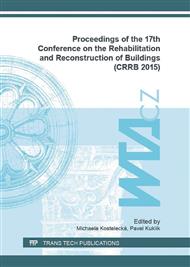p.3
p.10
p.15
p.20
p.25
p.29
p.35
p.40
Coefficients of Transverse Contraction of the Wood Cell Constituents and their Effect on the Cell Behavior
Abstract:
Wood cells are composed of cellulose, hemicellulose, and lignin. Geometrically we can idealize them as a set of hollow cylinders touching each other on the cylinder surface. The continuous displacements and stress state transmission are assumed on the cylinder surfaces. The article investigates stress development which is influenced by the wood cell axial elongation. Material properties of individual constituents are generally described by nine parameters characterizing orthotropic elastic material. Transversely isotropic constitutive model of was chosen for simplification. The analytical solution of the stress state was driven by the ideas of displacement method. Material parameters have been estimated according to available literature. The main task of our investigation was focused on the effect of transversal contraction. The actual calculation results are surprising and lead to reflection. These considerations and conclusions are summarized at the end of the paper.
Info:
Periodical:
Pages:
20-24
Citation:
Online since:
September 2016
Authors:
Price:
Сopyright:
© 2016 Trans Tech Publications Ltd. All Rights Reserved
Share:
Citation:


